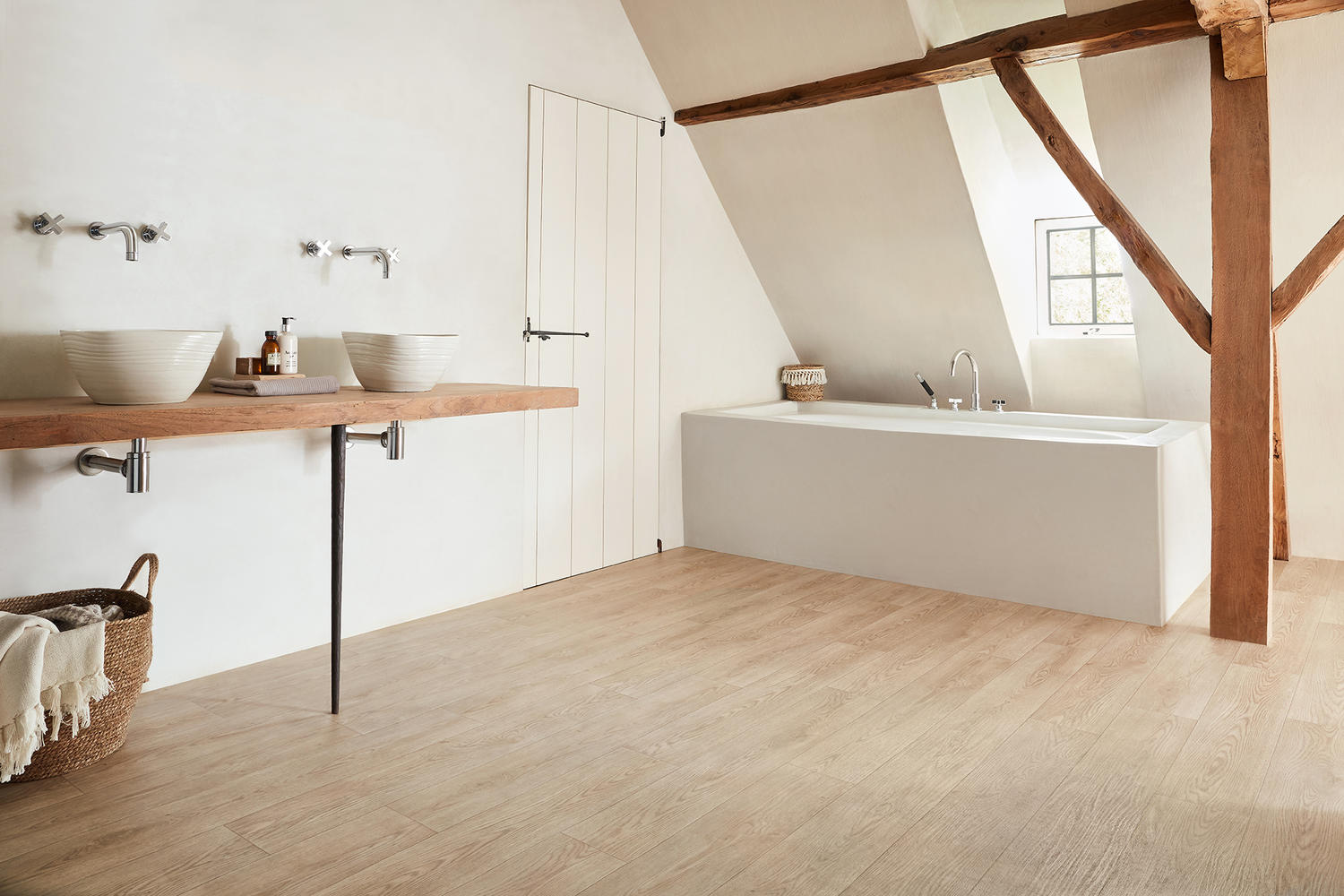Laminate Flooring

Laminate flooring has gained popularity in recent years due to its affordability, durability, and wide range of styles. However, when it comes to bathrooms, a room known for its moisture and humidity, questions arise about the suitability of laminate flooring. While laminate flooring is not traditionally considered ideal for bathrooms, advancements in technology have led to the development of moisture-resistant options that make it a viable choice for some homeowners.
Laminate Flooring in Bathrooms: Pros and Cons
Laminate flooring is a composite material made of layers that include a wear layer, a decorative layer, and a core layer. While the traditional laminate flooring is not waterproof, newer advancements have introduced moisture-resistant laminate flooring specifically designed for areas like bathrooms.
- Pros:
- Moisture Resistance: Moisture-resistant laminate flooring features a core layer that is designed to withstand exposure to water. This makes it a suitable choice for bathrooms, especially those with minimal water exposure, such as powder rooms or guest bathrooms.
- Durability: Laminate flooring is known for its durability, able to withstand heavy foot traffic and resist scratches and dents. This makes it a practical choice for a high-traffic area like a bathroom.
- Aesthetic Appeal: Laminate flooring offers a wide range of styles, mimicking the look of natural materials like wood, stone, and tile. This allows homeowners to achieve a desired aesthetic without the high cost of natural materials.
- Easy Installation and Maintenance: Laminate flooring is relatively easy to install and maintain. It can be installed over existing subfloors, making it a cost-effective option.
- Affordability: Laminate flooring is generally more affordable than other bathroom flooring options, such as ceramic tiles or hardwood.
- Cons:
- Water Resistance: While moisture-resistant laminate flooring is designed to withstand some water exposure, it is not completely waterproof. Prolonged exposure to water or standing water can damage the flooring.
- Limited Water Resistance: It’s crucial to understand that moisture-resistant laminate flooring is not fully waterproof. It can withstand spills and splashes but not continuous exposure to water.
- Durability: Laminate flooring can be susceptible to scratches and dents, especially in areas with heavy foot traffic or furniture movement.
- Installation: While laminate flooring is relatively easy to install, it can be challenging in areas with complex layouts or uneven subfloors.
- Wood-look Laminate: This popular choice offers the warmth and natural beauty of real wood, but with the durability and water resistance of laminate. Wood-look laminate is available in a wide range of colors, grains, and finishes, including traditional oak, rustic hickory, and contemporary walnut.
- Stone-look Laminate: This option provides the elegant and sophisticated look of natural stone, such as marble, granite, and slate. Stone-look laminate is often available in a variety of colors and patterns, including veined marble, textured slate, and polished granite.
- Tile-look Laminate: This option mimics the look of ceramic or porcelain tiles, offering a clean and modern aesthetic. Tile-look laminate is available in a variety of sizes, shapes, and colors, including traditional square tiles, modern rectangular tiles, and intricate mosaic patterns.
- Light Colors: Light-colored laminate flooring can brighten up a small bathroom and make it feel more spacious. White, cream, and light gray are popular choices for creating a clean and airy atmosphere.
- Dark Colors: Darker laminate flooring can add a touch of drama and sophistication to a bathroom. Brown, black, and navy are popular choices for creating a bold and elegant look.
- Neutral Colors: Neutral colors, such as beige, taupe, and gray, are a versatile choice for bathrooms, as they can complement a wide range of color palettes and styles.
- Traditional Bathrooms: Traditional bathrooms often feature warm, earthy tones and classic design elements. Wood-look laminate flooring in a rich brown or cherry finish can complement this style. Consider incorporating decorative moldings or wainscoting to enhance the traditional aesthetic.
- Modern Bathrooms: Modern bathrooms are characterized by clean lines, minimalist design, and a focus on functionality. Stone-look laminate flooring in a neutral gray or white finish can create a sleek and contemporary look. Consider incorporating geometric patterns or bold accents to enhance the modern aesthetic.
- Minimalist Bathrooms: Minimalist bathrooms emphasize simplicity and functionality. Tile-look laminate flooring in a neutral color, such as white or gray, can create a clean and uncluttered look. Consider using a single color or pattern throughout the bathroom to maintain a minimalist aesthetic.
Design and Style Options: Is Laminate Wood Flooring Good For Bathrooms

Laminate flooring offers a wide range of design and style options, making it a versatile choice for bathrooms. Water-resistant laminate flooring is particularly well-suited for this space, as it can withstand moisture and spills.
Is laminate wood flooring good for bathrooms – Here’s a closer look at the design possibilities and how they can enhance your bathroom’s aesthetic:
Patterns and Textures
Laminate flooring comes in a variety of patterns and textures, mimicking the look of natural materials like wood, stone, and tile. This versatility allows you to create a wide range of bathroom styles, from classic to modern.
Colors and Finishes
The color and finish of your laminate flooring can have a significant impact on the overall feel of your bathroom. Lighter colors, such as white, cream, and light gray, can create a sense of spaciousness and airiness. Darker colors, such as brown, black, and navy, can add a touch of drama and sophistication.
Bathroom Design Styles, Is laminate wood flooring good for bathrooms
Laminate flooring can be incorporated into a variety of bathroom design styles, from traditional to modern.
